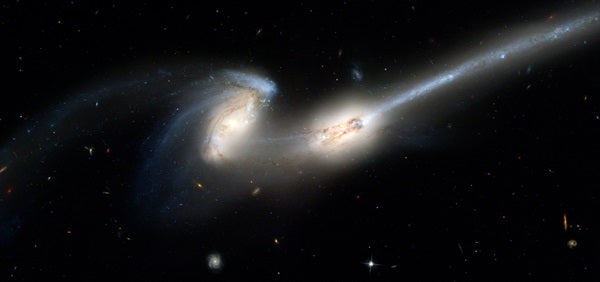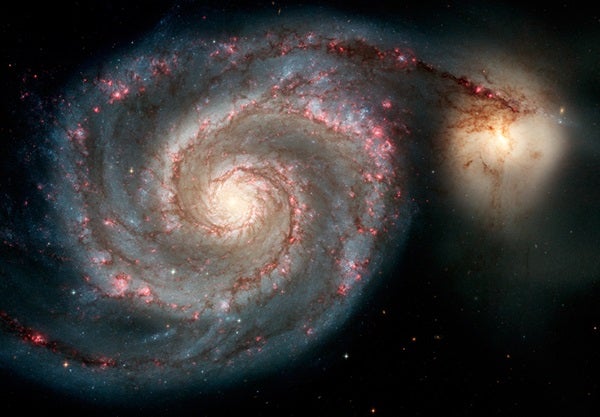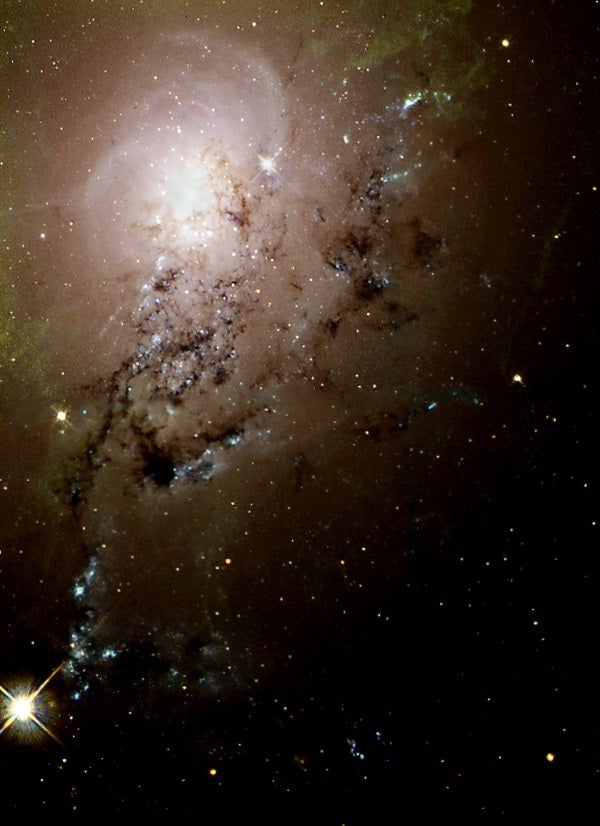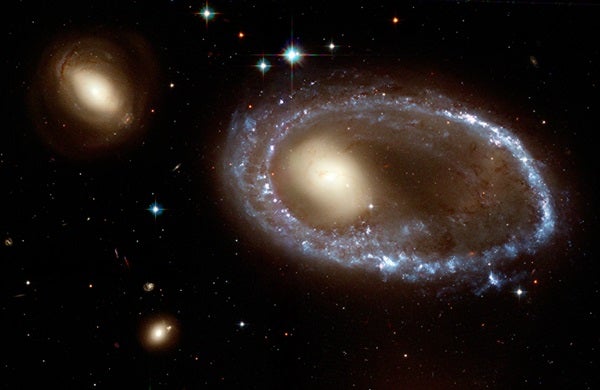The vastness of space astounds us. Everywhere we look in the night sky, darkness abounds. The distances even to the nearest stars are so vast that caverns of emptiness exist between most objects in the cosmos. And the voids between the majority of galaxies are millions of times larger.
Despite the bigness of space, things do go bump in the night. Even on large cosmic scales, in galaxy clusters and groups, whole galaxies slam into each other in ornate dances that last tens of millions of years.

Bringing the universe to your door. We’re excited to announce Astronomy magazine’s new Space and Beyond subscription box – a quarterly adventure, curated with an astronomy-themed collection in every box. Learn More >>.
Even with relatively small telescopes, examples of merging galaxies are visible to backyard astronomers on Earth. In Canes Venatici, the Whirlpool Galaxy’s small companion, NGC 5195, is a separate island universe passing it in the night.
Cetaurus A, the great high-energy galaxy in the southern sky, is the merged debris from a head-on collision of two galaxies. NGC 4038 and NGC 4039 in Corvus, known as the “Antennae” galaxies, provide a beautiful view of two highly disrupted galaxies with an adjoined arm. In Coma Berenices, NGC 4676A and B, the “Mice,” show a beautiful interaction, with a long arm shooting out one side of the merging pair of galaxies.
In the violent world of stars, gas, and interstellar dust, most galaxies that collide merge fully into a single chaotic object. “Minor mergers, those between a large and a small galaxy,” says Yale University astronomer Daniel Christlein, “may well be a normal part of galaxy life.”
In order for galaxies to merge, only two basic conditions need to be met: They must be relatively near each other, and they must be traveling at relatively slow speeds with respect to each other.
If galaxies are too far apart, their gravitational attraction would be too weak to draw them together. If they are moving too quickly relative to each other, they might pass like ships in the night.
So what happens when galaxies approach? If the interaction takes place between two galaxies of different sizes, the larger object normally draws the small one into a long arc, extending it like taffy being pulled apart. The large object is relatively unaffected.
More interesting, however, are mergers between galaxies of similar sizes. Then, the fireworks start in earnest. Enormous tails of matter can be ejected; huge regions of new star formation take place as gravity compresses gas clouds; and chaotic disruption deep inside the galaxies can reorder the matter within them in wholesale fashion.
The basic building block of galaxies, hydrogen gas, is the fuel that gets twisted around in galaxy mergers. “Gas in the inner disk responds to the change in gravitational potential,” says astronomer Daisuke Iono of the University of Massachusetts and the Harvard-Smithsonian Center for Astrophysics. “[It] loses energy and angular momentum, and flows toward the central regions of the galaxy. Numerical simulations predict radial gas inflow in the early stages, when the two galaxies collided for the first time, as well as during the final coalescence.”
In a study of galaxy mergers conducted by Iono and his colleagues, the astronomers found the flow takes place rapidly and then slows down after more than half the gas reaches a galaxy’s center. The gas then forms a ring around the galaxy’s center that can trigger the bursts of star formation often seen in galaxy interactions. Dormant central black holes in galaxies can also get an injection of gas that “wakes up” the black-hole engine. This produces violent activity observed in the cores of active galaxies undergoing mergers.
The vastness of space holds true on stellar scales. The distances between stars are large enough that even as galaxies merge, their stars rarely collide. The fact that galaxies are mostly empty space holds true even as matter is compressed and galaxies, on the whole, are rocked apart. If the Sun’s neighborhood of stars equaled the density of galaxies in the Local Group, our sky would be illuminated by a few stars brilliantly shining inside the orbit of Pluto!
Inside clusters and groups, galaxies collide all the time. Mergers are commonplace. Although they occur over vastly long timescales, galaxies routinely come together and become one. In fact, even our Milky Way will undergo a collision and merge with another galaxy. One day, this will rock our galaxy to its core.













